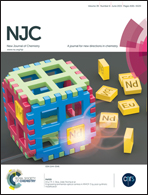Synthesis and NMR and mass spectrometric study of ammonioacetohydrazones of formylphenylboronic acids as novel ionic prospective sugar receptors†
Abstract
Novel sugar-sensing, soluble in aqueous media, boronic acid derivatives designed for easy analysis through MALDI mass spectrometry have been synthesized in a high yield through a mild and efficient procedure. The synthesized compounds are based on formylphenylboronic acids, which can bind through the formyl group with acid hydrazides to form the respective hydrazones. As hydrazide substrates, Girard reagents T and P were chosen, which possess precharged ammonium and pyridinium moieties, respectively. Nuclear magnetic resonance spectroscopy (1H, 13C, HSQC, HMBC, and NOESY) and mass spectrometry were employed to study their structure, conformational equilibrium and interaction with selected sugars and other diols. Our study shows that the ammonioacetohydrazones of formylphenylboronic acids are present in DMSO solution in the form of cis/trans amide conformers and the effectiveness of their interaction with sugars depends on the situation of the substituent in relation to the boronic acid group. Introducing an ionic group to the receptor molecule improves the sensitivity for conjugate detection when analyzed by MS with matrix-assisted laser desorption/ionization (MALDI) in the positive-ion mode.


 Please wait while we load your content...
Please wait while we load your content...